What are sockets coated with?
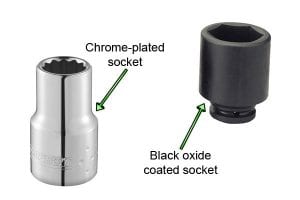
The two common surface finishes applied to sockets are: chrome plating and black oxide.The main purpose of a surface finish on a socket is to protect it from corrosion.
Different finishes are suited to different types of socket, with black oxide being used on impact sockets and chrome plating used on other sockets.
Black-Oxide Coatings
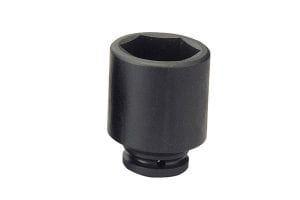
Black oxide is mainly used on impact sockets because chrome and matt chrome plating can become chipped or flake off when subjected to impact from an impact wrench. This would remove the corrosion protection from the surface of the socket if it had one of these finishes.
Why is corrosion protection important?

As sockets are made of steel, if they corrode, a layer of rust will form on the socket. A build-up of rust will affect the dimensional accuracy of the socket, meaning it may not fit onto the fastener head or the drive square of your turning tool.
The rust layer will not be as strong as the rest of the socket, which could have several negative effects.
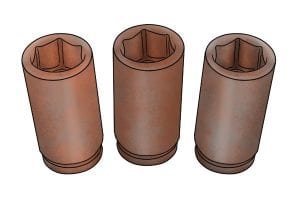
These negative effects are.
The rust layer is likely to wear off as the socket is used, which will remove material from inside the socket altering its size and shape, increasing the chance of the socket rounding the fastener head.
If enough of the sockets internal head recess has rusted away, then, as the rust is worn off, the socket walls may no longer make contact with the fastener head, simply spinning around it and not turning it.
As the rust eats away at the socket, it will become weaker, increasing the possibility of the socket breaking. This is especially true of impact sockets due to the additional forces and vibration they are subjected to.
Chrome Plating
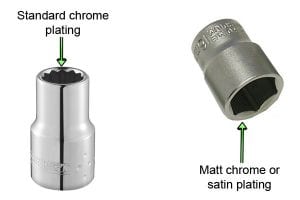
Chrome plating is the most common surface finish found on sockets. It is used in two forms: standard chrome and matt chrome or satin, and is designed to provide corrosion protection to the finished socket.
Standard Chrome
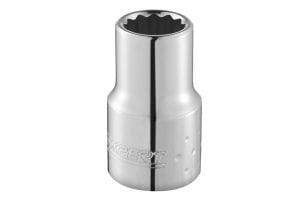
Standard chrome is the most common type of finish on sockets. It gives sockets a shiny mirror-like finish, which helps protect them from corrosion.
Matt Chrome or Satin
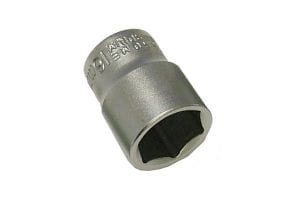
Matt chrome, sometimes called ‘a satin finish’, is a matt (not shiny) finish used on some sockets instead of chrome plating. Matt chrome has a few advantages over standard chrome plating. Firstly, as it is not shiny, it will not reflect glare and light as much as chrome plating does. Matt chrome also does not show fingerprints or scratches as much as regular chrome plating.
Glare can be a problem when using an inspection lamp in a dark confined space, as it can obscure your view of what you are working on.
How is chrome plating applied to sockets?
Once the socket has been formed and has undergone heat treatment and tempering to adjust its hardness and toughness (see How are sockets manufactured? for more details), it can then be chrome plated.
Step 1 – Abrasive cleaning
The first stage in the chrome plating process is an abrasive cleaning process that blasts small steel particles at the sockets whilst they are tossed in a large rotating metal drum. This also buffs the surface of the socket.
Step 2 – Grinding
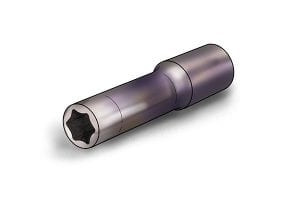
A grinding wheel is then used to buff the outer surface of the sockets.
Step 3 – Acid Cleaning
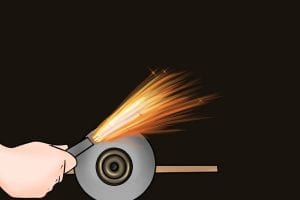
The next stage is another cleaning process. This time, the sockets are placed in a rotating bath containing ceramic stones which rub acid over the sockets. This removes any blemishes that may remain on the surface. After this, the sockets are rinsed with a degreaser, and dried to remove any remaining acid.
Step 4 – Chrome Bath
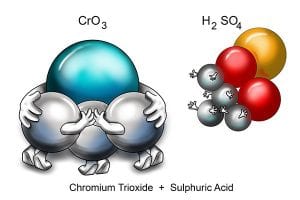
The sockets are now ready to be placed in a chrome bath which contains chromium trioxide (CrO3) and sulphuric acid (H2SO4), and has an electrical current passed through it.
By altering the ratio of chromium trioxide to sulphuric acid, the temperature and the amount of electrical current passed through the solution, it is possible to alter the finish of the chrome plating on the socket.
Step 5 – Rinse and Dry

The sockets are then rinsed to remove any remaining chromium trioxide and sulphuric acid, before being placed in a centrifuge and spun to dry them.
Black Oxide
Black oxide has many trade names such as: ‘gun bluing’, ‘black magic’, ‘black penetrate’, ‘industrial finish’ and others.It is mainly used on impact sockets because chrome and matt chrome plating can become chipped or flake off when subjected to impact from an impact driver. This would remove the corrosion protection from the surface of the socket if it had one of these finishes.
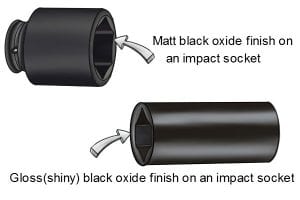
On sockets, black oxide is nearly always a matt finish, although it is possible to achieve a gloss finish as well.Black oxide does not affect the dimensions, hardness or temper of the object it is applied to, and will not chip or wear off.
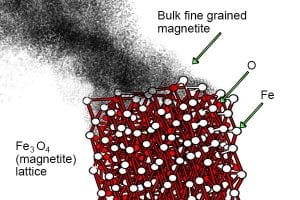
Unlike chrome plating, which only bonds to the surface and does not chemically react, black oxide is actually a coating formed due to a chemical reaction with the iron in the metal, to produce a protective surface of magnetite (Fe3O4).

Black oxide can be applied in either a “hot” or “cold” oxidizing process. However, the cold process does not provide a true oxide coating and so offers less resistance to corrosion and abrasion. As a result, cold black oxide coatings do not meet military or automotive specifications for black oxide and should not be used on these sockets.
How is black oxide applied?
Step 1 – Alkaline Bath
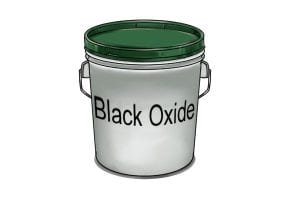
Black oxide is applied by dipping the parts to be coated in a series of bath solutions. This starts with an alkaline cleaner which cleans the surface of any impurities or dirt. The parts are then placed in a water bath to wash off any remaining alkaline solution.
Step 2 – Caustic Soda Bath
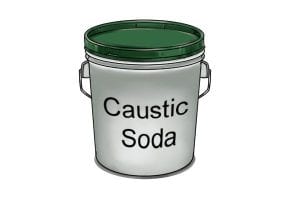
The next bath is in caustic soda (blackening compound) heated to 140.5°C. This bonds chemically to the surface of the part and forms a porous base layer. A second water bath is then used to rinse off the caustic soda before the final sealing bath.
Step 3 – Seal with Oil or Wax
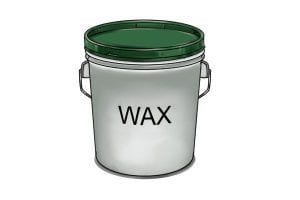
The sealant is usually an oil or wax, which fills pores formed during the caustic soda bath. It is this that provides the corrosion resistance to the black oxide surface finish.
Which coating should you choose?
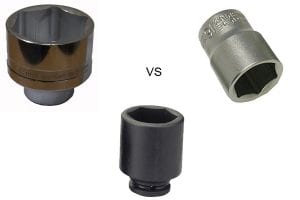
It is important to think about what material your socket is made of and what job you need it to do before you pick which coating is best.
Black oxide should always be the coating chosen for impact sockets, because chrome plating will chip and wear off with the vibration and impact forces exerted by impact drivers.The choice of which coating for standard sockets is more down to personal preference, although many people prefer matt chrome as it creates less glare than standard chrome.
Some users also find that matt chrome sockets are less slippery when you are using them with oily or greasy hands than sockets with other coatings.
What are sockets coated with?
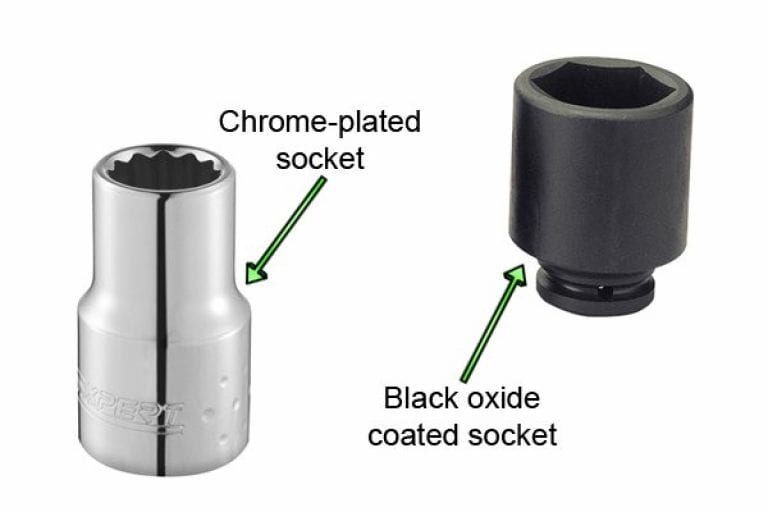
The two common surface finishes applied to sockets are: chrome plating and black oxide.The main purpose of a surface finish on a socket is to protect it from corrosion.
Different finishes are suited to different types of socket, with black oxide being used on impact sockets and chrome plating used on other sockets.
Black-Oxide Coatings

Black oxide is mainly used on impact sockets because chrome and matt chrome plating can become chipped or flake off when subjected to impact from an impact wrench. This would remove the corrosion protection from the surface of the socket if it had one of these finishes.
Why is corrosion protection important?

As sockets are made of steel, if they corrode, a layer of rust will form on the socket. A build-up of rust will affect the dimensional accuracy of the socket, meaning it may not fit onto the fastener head or the drive square of your turning tool.
The rust layer will not be as strong as the rest of the socket, which could have several negative effects.

These negative effects are.
The rust layer is likely to wear off as the socket is used, which will remove material from inside the socket altering its size and shape, increasing the chance of the socket rounding the fastener head.
If enough of the sockets internal head recess has rusted away, then, as the rust is worn off, the socket walls may no longer make contact with the fastener head, simply spinning around it and not turning it.
As the rust eats away at the socket, it will become weaker, increasing the possibility of the socket breaking. This is especially true of impact sockets due to the additional forces and vibration they are subjected to.
Chrome Plating

Chrome plating is the most common surface finish found on sockets. It is used in two forms: standard chrome and matt chrome or satin, and is designed to provide corrosion protection to the finished socket.
Standard Chrome

Standard chrome is the most common type of finish on sockets. It gives sockets a shiny mirror-like finish, which helps protect them from corrosion.
Matt Chrome or Satin

Matt chrome, sometimes called ‘a satin finish’, is a matt (not shiny) finish used on some sockets instead of chrome plating. Matt chrome has a few advantages over standard chrome plating. Firstly, as it is not shiny, it will not reflect glare and light as much as chrome plating does. Matt chrome also does not show fingerprints or scratches as much as regular chrome plating.
Glare can be a problem when using an inspection lamp in a dark confined space, as it can obscure your view of what you are working on.
How is chrome plating applied to sockets?
Once the socket has been formed and has undergone heat treatment and tempering to adjust its hardness and toughness (see How are sockets manufactured? for more details), it can then be chrome plated.
Step 1 – Abrasive cleaning
The first stage in the chrome plating process is an abrasive cleaning process that blasts small steel particles at the sockets whilst they are tossed in a large rotating metal drum. This also buffs the surface of the socket.
Step 2 – Grinding

A grinding wheel is then used to buff the outer surface of the sockets.
Step 3 – Acid Cleaning

The next stage is another cleaning process. This time, the sockets are placed in a rotating bath containing ceramic stones which rub acid over the sockets. This removes any blemishes that may remain on the surface. After this, the sockets are rinsed with a degreaser, and dried to remove any remaining acid.
Step 4 – Chrome Bath

The sockets are now ready to be placed in a chrome bath which contains chromium trioxide (CrO3) and sulphuric acid (H2SO4), and has an electrical current passed through it.
By altering the ratio of chromium trioxide to sulphuric acid, the temperature and the amount of electrical current passed through the solution, it is possible to alter the finish of the chrome plating on the socket.
Step 5 – Rinse and Dry

The sockets are then rinsed to remove any remaining chromium trioxide and sulphuric acid, before being placed in a centrifuge and spun to dry them.
Black Oxide
Black oxide has many trade names such as: ‘gun bluing’, ‘black magic’, ‘black penetrate’, ‘industrial finish’ and others.It is mainly used on impact sockets because chrome and matt chrome plating can become chipped or flake off when subjected to impact from an impact driver. This would remove the corrosion protection from the surface of the socket if it had one of these finishes.

On sockets, black oxide is nearly always a matt finish, although it is possible to achieve a gloss finish as well.Black oxide does not affect the dimensions, hardness or temper of the object it is applied to, and will not chip or wear off.

Unlike chrome plating, which only bonds to the surface and does not chemically react, black oxide is actually a coating formed due to a chemical reaction with the iron in the metal, to produce a protective surface of magnetite (Fe3O4).

Black oxide can be applied in either a “hot” or “cold” oxidizing process. However, the cold process does not provide a true oxide coating and so offers less resistance to corrosion and abrasion. As a result, cold black oxide coatings do not meet military or automotive specifications for black oxide and should not be used on these sockets.
How is black oxide applied?
Step 1 – Alkaline Bath

Black oxide is applied by dipping the parts to be coated in a series of bath solutions. This starts with an alkaline cleaner which cleans the surface of any impurities or dirt. The parts are then placed in a water bath to wash off any remaining alkaline solution.
Step 2 – Caustic Soda Bath

The next bath is in caustic soda (blackening compound) heated to 140.5°C. This bonds chemically to the surface of the part and forms a porous base layer. A second water bath is then used to rinse off the caustic soda before the final sealing bath.
Step 3 – Seal with Oil or Wax

The sealant is usually an oil or wax, which fills pores formed during the caustic soda bath. It is this that provides the corrosion resistance to the black oxide surface finish.
Which coating should you choose?

It is important to think about what material your socket is made of and what job you need it to do before you pick which coating is best.
Black oxide should always be the coating chosen for impact sockets, because chrome plating will chip and wear off with the vibration and impact forces exerted by impact drivers.The choice of which coating for standard sockets is more down to personal preference, although many people prefer matt chrome as it creates less glare than standard chrome.
Some users also find that matt chrome sockets are less slippery when you are using them with oily or greasy hands than sockets with other coatings.






